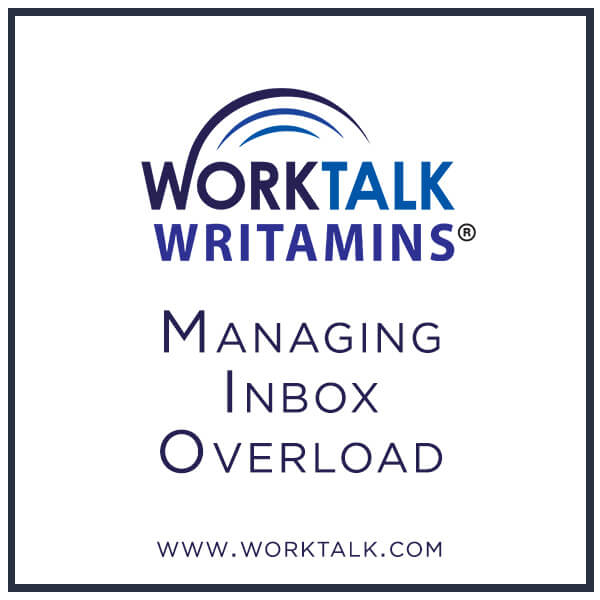
[6 minutes to read]
“There are days where I literally sit down at my computer and don’t plan on doing anything. I just start replying to e-mails that came in the night before and then the ones that start coming in that day and 10 hours later I try and stop. My entire day is filled with fighting the fires. Or, trying to get done what should have been done already.”
This quote came from an executive responding to a Worktalk survey about email response habits. He is not alone in feeling overwhelmed, beleaguered, and hopeless about managing his email load
With the rise of overflowing inboxes comes the need to manage our time spent on email. Here are a few tips that Worktalk clients and friends have shared with me about how they manage their email time. I hope they are useful to you.
Take time for yourself before you start emailing in the morning.
Start your day with a clear mind before you jump into email. Meditate, reflect, or just let the caffeine kick in before you start opening emails. You will feel more in control of your time for the rest of the day.
Have someone else filter your email for you.
Do you really need to be the person who sorts the wheat from the chaff? A competent assistant can probably winnow out the important emails and give you a manageable number to deal with.
Create folders and filters to pre-sort your email.
Most email programs include functions for sorting your email. Whether they call them rules or filters or folders, the programs have ways to protect you from the onslaught of unsorted email. Use them.
Use email for what it’s good for, not for what it’s not.
Email is an extraordinary tool that you can use for many purposes. However, it is not a tool for everything. If five people need to weigh in on an idea, email is not the best tool for the job. Use Google Docs or, best of all, schedule a conference or Zoom call and work out in five minutes what would have taken multiple email chains to resolve. As any mechanic can say, it’s best to choose the right tool for the job.
Schedule times for responding to email.
Reading and responding to email is a basic business activity: Don’t try to squash it into gaps in your day. If you want to kill your focus and productivity, keep email open on a second screen or check it at every spare minute. This practice is literally bad for your brain.
Instead, use time blocking. Set a timer for a reasonable period – 30, 45, or 50 minutes. Do concentrated work for that time. When the timer beeps, just do email for 10 or 15 minutes. Then go back to work. Your productivity will increase.
The intervals between email checking will vary based on your job responsibilities: The point is that a person rarely needs to be “on” email all the time.
“But my clients expect me to respond right away!”
If everyone expects you to respond to their emails immediately, you have trained them to have this expectation. In order to regain your sanity and control over your time, you need to retrain them.
Let people know that in the service of doing more concentrated, productive work, you have changed your email policy and will now be checking email at certain times. You decide what’s realistic for your life. A busy executive wrote to me that he checks at 6 am and at 4 pm and tells people that if they need to reach him between those times, they can call or text him.
You may have a few VIP clients whose emails always get an immediate response, but you do not need to respond to everyone right away just because they felt like pressing SEND.
How urgent is it, anyway?
Remember: No one is going to die if you don’t respond to that email immediately. You’re not the ER doctor emailing the ambulance, saying “Defibrillate!”. If the person waits while you reflect on your response, the world is unlikely to end.
Based on your business, your role, and your relationship with the sender, you will decide how long the sender can wait for a reply. But I implore you: Get a grip on the email monster before it undermines your health and peace of mind.
Resources
Anderson School alum Al Sargent recommended these useful tools:
https://lifehacker.com/empty-your-inbox-with-the-trusted-trio-182318
https://unpacked.mailbutler.io/2019/01/09/gtd-email-inbox-zero-flowchart/

©2019 Elizabeth Danziger All rights reserved
